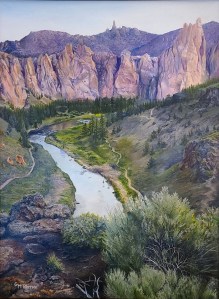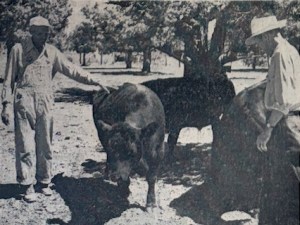For Oregon spotted frogs in the Deschutes River, life finds a way
Published 5:45 am Thursday, May 16, 2024

- U.S. Fish & Wildlife biologist Jennifer O’Reilly looks for signs of spotted frog eggs and talks about the conditions in which spotted frogs will lay eggs while in a wetland near the Slough Day Use Area southwest of Bend.
In a wetland near the banks of the Upper Deschutes River, Jennifer O’Reilly stepped cautiously into half a foot of water in search of an elusive creature whose small size belies its importance. Crouching in a pair of waders, she peered through oversized sunglasses into a dark pool reflecting cotton ball clouds and blue sky.
Trending
The Oregon spotted frog, a rare amphibian O’Reilly has researched for over two decades, was her focus. The frogs have been breeding and depositing egg masses in shallow ponds across the region since late March.
Brushing away sedges and rushes, O’Reilly, a senior biologist with the U.S. Fish and Wildlife Service, sunk a hand into the water.
“I can feel where it’s warm and where the wind is not blowing and that is where I can hone in on them. And I just have a sixth sense for it,” she said.
Trending
Counting egg masses is one of the best ways for biologists to understand frog populations and habitat trends. Spotting one is evidence of two adult frogs in the area. They are often laid communally, so a pile of 20 masses tells the biologist at least 40 adults are nearby.
With population data at their fingertips, scientists can make informed decisions on managing the species and improving their numbers.
Positive results
This year, O’Reilly has conducted egg mass counts throughout the Upper Deschutes River basin, including the Little Deschutes River. She’s also tackled other known spotted frog breeding sites, most recently at Little Lava Lake. Overall, the results have been positive.
“The survey is still going but so far, it looks pretty good,” said O’Reilly. “As far as the number of eggs we are seeing compared to the past two years, across the range.”
O’Reilly’s research is part of fish and wildlife service’s attempts to recover Oregon spotted frog numbers. The distinctive frog — olive brown to brick red with black spots on its back — was listed in 2014 as a threatened species under the Endangered Species Act. The Upper Deschutes Basin is considered a critical habitat for its survival.
Read more: Plan to conserve water for the Deschutes gets go-ahead
“Central Oregon is the stronghold, it’s the place where the frogs are doing the best,” said O’Reilly. “You hear that buzz that they are not doing well. But we are doing way better here than most of the range, from Klammath to British Columbia.”
Stabilizing spotted frog numbers in the Upper Deschutes is partly attributed to recent environmental rules that require irrigation districts to leave more water in the river in winter.
Those rules have not been without controversy. Some Central Oregon farmers questioned the need to use water for frog habitat when it could be used to grow crops and other agricultural products. But biologists say increasing water for frogs is delivering results.
“We have stopped the bleeding. Now we are trying to rebuild the system,” said Bridget Moran, the supervisor of fish and wildlife’s Bend office. “The farmer’s contribution is helping.”
Read more: Farmer’s patience wearing thin for 30-year plan to raise the Deschutes
Impact on the entire ecosystem
O’Reilly emphasizes the symbiotic relationships between different species along the Deschutes and how water is the common thread binding them.
Spotted frogs, for example, are known to overwinter in beaver dens and utilize channels created by beaver for their migration patterns. Muskrats, a semiaquatic rodent, also facilitate spotted frog movements.
“Muskrats and beavers are critical to (the frog’s) survival which is why you need water, because those animals need water, too,” said O’Reilly. “So it’s the whole ecosystem function and hopefully that is what the winter flows and Habitat Conservation Plan will provide.”
When the water disappeared from areas along the Upper Deschutes during the last half of the 20th century, the aquatic ecosystem started to collapse for all its species. Recovery of these species involves strategic water management practices so nothing is wasted.
“We work with the irrigators to try to mimic a more natural flow regime so that the frogs can recover,” said Moran.
Read more: U.S. Fish and Wildlife could face lawsuit over spotted frog protections
That mimicking of nature involves a gradual decrease of water in fall, helping juvenile frogs disperse and establish new populations. It also sends a signal to the frogs that they must start migrating to their winter habitat.
“We do that in a gradual fashion so they can get into those locations before the wetlands disconnect from the river again,” said Moran.
In spring, the biologists again work with the districts to raise the water gradually when the frogs are breeding. The goal is to protect egg masses from the up-and-down swings of water levels.
“If (the egg masses) go down they will be sitting in the mud. If they go up they will get flushed into the river, so we try to keep it gradual in the spring,” she said.
Waiting for nature to heal
Back at Slough Camp, the daily grind of survival played out for the vulnerable spotted frog. Threats loomed all around. Usually, it’s the non-native species — bullfrogs and introduced fish — that make a meal of them. Native fauna, including snakes, cranes and great blue herons, feed on spotted frog eggs, and sometimes the frogs themselves.
In the mid-day sun, the frogs remained hidden in the vegetation, avoiding predators while awaiting their own opportunity to locate an insect lunch.
In the meantime, springtime water from the Deschutes River is slowly rising, creating moisture in wetland ponds and side channels that were dry during the winter. The rising water fills the beaver channels, providing migration corridors for the frogs.
Biologists like O’Reilly and Moran wait and watch for habitat improvements that help the frog connect to nearby populations. And they urge others to remain patient as changes unfold.
“It’s not a switch. If water then frogs immediately,” said Moran. “Biology takes time.”
The Deschutes Basin Habitat Conservation Plan requires irrigation districts to raise the winter flow of the Deschutes River from its current minimum of 100 cubic feet per second to 300 cfs by 2028. Then by 2033, the releases must hit a minimum of 400 cfs in winter, with provisions for up to 500 cfs.
The plan can be renegotiated in 2051. Until then it has requirements for every gauge in the Deschutes Basin for every day for 30 years.
The eight irrigation districts in Central Oregon and the city of Prineville are party to the plan. After 12 years in development, it was formally adopted by the U.S. Fish and Wildlife Service on Dec. 31, 2020. Fish and wildlife has partnered with several non-profits and agencies to actively manage spotted frog habitat. These include the Deschutes River Conservancy, the U.S. Forest Service, the U.S. Geological Society, Oregon Department of Fish and Wildlife, and the Upper Deschutes Watershed Council.
The hope is by the early 2050s the Oregon spotted frog population can recover and come off the list of endangered species. Biologists say the Upper Deschutes will be at the vanguard of this effort because as it currently stands, spotted frog populations are losing ground across most of their range, from Klamath to British Columbia.
• Juvenile spotted frogs start to sexually mature at around one year for males and two years for females, although this may take longer depending on site, conditions, and resources.
• Mating occurs between March and June, depending on elevation, and the eggs are laid in shallow areas of waterbodies that are typically no more than six inches deep.
• The globular, grapefruit-sized egg masses each contain around 900 to 1,200 embryos. The females lay them communally in piles.
• Tadpoles graze on plants and bacteria. They morph into froglets after around four months.
• Only around 1% of the eggs within an egg mass survive to become frogs. When fully grown they are two to four inches from snout to vent.
• Spotted frogs usually live between two to five years in the wild.








